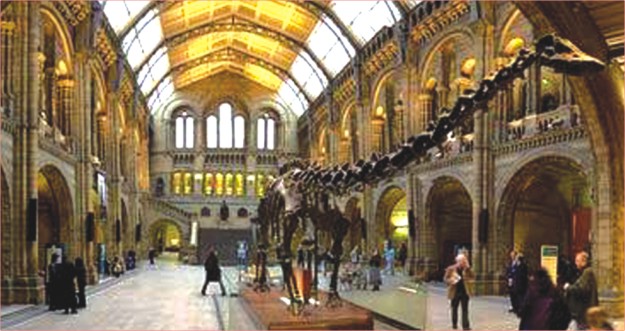Heritage
Coming Close To Nature:
Natural History Museum, London
Jasmine Jaim

While entering the Natural History Museum, I said to my grandmother (a retired school teacher of England), “Look! I don't like animals or such things! So, I am not going to spend much time in here!” Just after completing the sentence, I looked through the way in and found a giant skeleton of a dinosaur at the fantastic cathedral-like structured central hall. I simply shouted, “Wow! I will have to see all these….”
The Natural History Museum first opened its doors to the public in 1881, but its origins traces back to more than 250 years. It all started when physician and collector of natural curiosities, Sir Hans Sloane, left his extensive collection to the nation in 1753. Originally his specimens formed part of the British Museum, but as other collections were added, including specimens collected by botanist Joseph Banks on his 1768-1771 voyage with Captain James Cook, the natural history elements needed their own home.
The Museum's Central Hall forms a fantastic backdrop to some of the highlights of the Museum's collections including that Diplodocus Dinosaur skeleton. This dinosaur was one of the longest land animals ever to live. However, it seemed to me that from the grand staircase a magnificent, substantial marble statue of Charles Darwin was overlooking the central hall. Besides, at the very top of the hall I found a section of trunk from the enormous giant sequoia tree (biggest living things). This tree was over 1,300 years old when it was felled!
 I found that the museum was divided into different zones. In the Green Zone I discovered amazing facts about life, the planet, our environment and evolution. Of this zone, in Fossil Marine Reptiles Section we uncovered what was going on in the oceans while the dinosaurs roamed the earth whereas in Creepy Crawlies Section we explored about ants, butterflies, crabs, spiders and thousands of their relatives. Besides, in the Bird section we came to view specimens ranging from a tiny hummingbird to a giant ostrich and in Primate Section we met our relatives! However, I was more interested in the Minerals Section that showed off raw, cut and polished gemstones. Close to it, there was another section called The Vault. There I found nature's most rare, unique and valuable treasures. The Vault contained a dazzling collection of the finest gems, crystals, metals and meteorites from all around the world. One significant collection was 'The Aurora Pyramid of Hope'. That was a world-class collection of 295 naturally coloured diamonds arranged in a triangle shaped area. This private collection took 25 years to bring together. I found that the museum was divided into different zones. In the Green Zone I discovered amazing facts about life, the planet, our environment and evolution. Of this zone, in Fossil Marine Reptiles Section we uncovered what was going on in the oceans while the dinosaurs roamed the earth whereas in Creepy Crawlies Section we explored about ants, butterflies, crabs, spiders and thousands of their relatives. Besides, in the Bird section we came to view specimens ranging from a tiny hummingbird to a giant ostrich and in Primate Section we met our relatives! However, I was more interested in the Minerals Section that showed off raw, cut and polished gemstones. Close to it, there was another section called The Vault. There I found nature's most rare, unique and valuable treasures. The Vault contained a dazzling collection of the finest gems, crystals, metals and meteorites from all around the world. One significant collection was 'The Aurora Pyramid of Hope'. That was a world-class collection of 295 naturally coloured diamonds arranged in a triangle shaped area. This private collection took 25 years to bring together.
Afterwards, we went to the Blue Zone. In Dinosaurs Section we explored the 160 million years of the dinosaur era. There with the visual aids, one could easily find out what the dinosaurs looked like, what they ate, how they fought and how they evolved. Suddenly, I came face to face with a terrifying T. rex! The giant realistic model scared me with the impression that I might be the next one on its list of victims! Then in Mammals Section we encountered incredible range of mammal diversity. There was a specific section of blue whale, the largest creature ever. There were also Fishes, Amphibians and Reptiles Section. In Human Biology Section we had a scope to listen to what a baby experiences in the womb, learn all about cells and genetics, have simple test of sensation, perception, memory or even truth detection.
In the Red Zone, we discovered the ever-changing planet. At the introduction phase, there was a giant metallic globe presided over Visions of Earth. We rid up through it to the upper galleries. To put our planet in its heavenly context, the lofty walls were ornamented with a celestial map.
The Orange Zone included Wildlife Garden - home to thousands of British plant and animal species throughout the seasons. Apart from this, Darwin Centre is enriched with vast collection of bottled specimens. It is also the world of cutting-edge natural science research.
The experience of Natural History Museum took me close to the nature our root!
(The author is the Lecturer of Institute of Business Administration, Jahangirnagar University)

|
